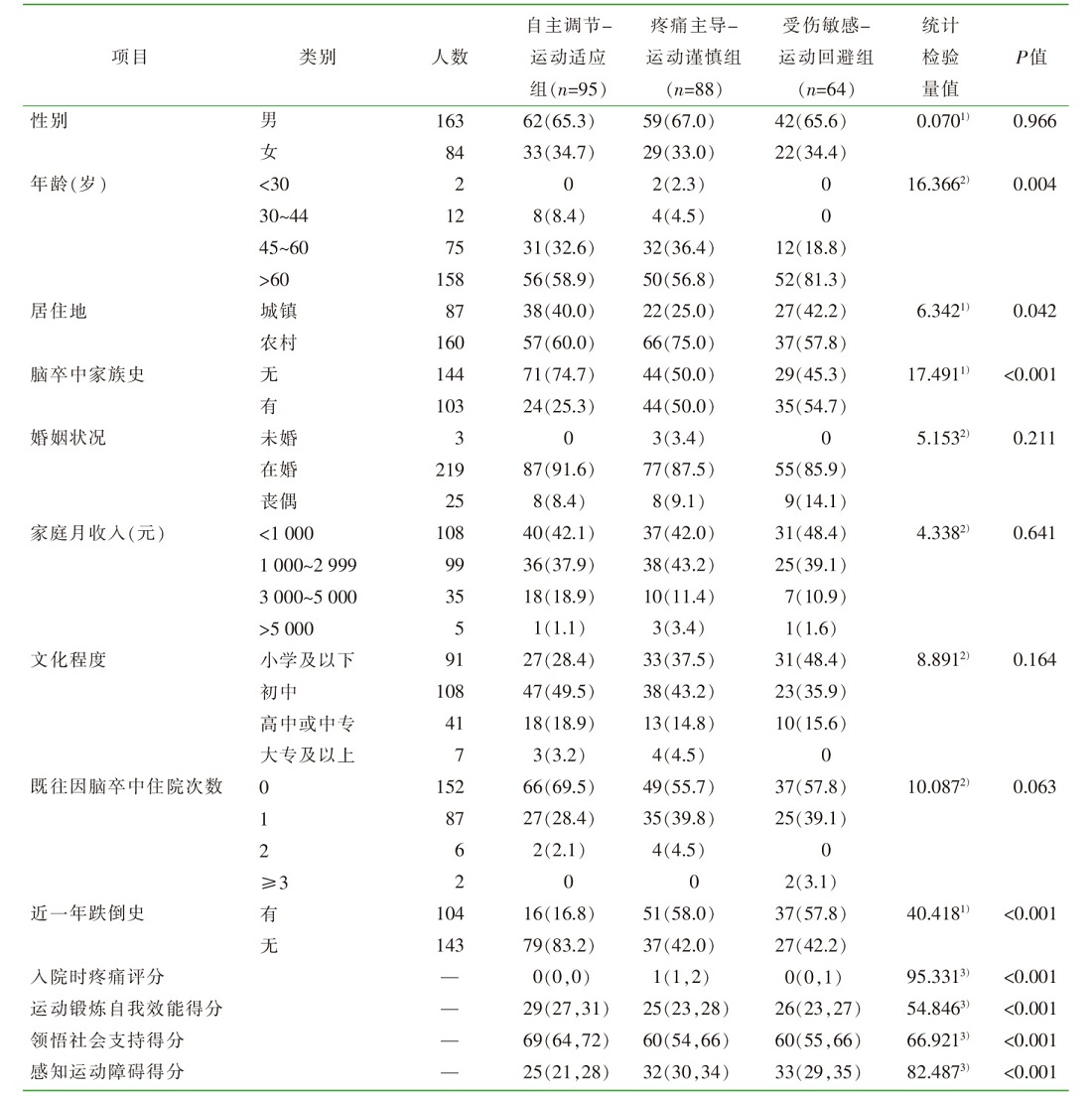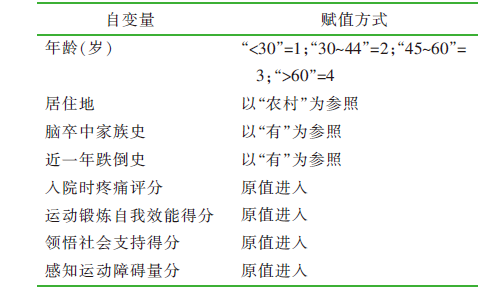| [1] |
Feigin VL, Brainin M, Norrving B, et al. World stroke organiza-tion:global stroke fact sheet 2025[J]. Int J Stroke, 2025, 20(2):132-144.
|
| [2] |
曲庆明, 贾杰. 脑卒中康复相关指南解读及展望[J]. 中国医刊, 2022, 57(5):487-490.
|
|
Qu QM, Jia J. Interpretation and prospect of guidelines related to rehabilitation of stroke[J]. Chin J Med, 2022, 57(5):487-490.
|
| [3] |
Lee KE, Choi M, Jeoung B. Effectiveness of rehabilitation exer-cise in improving physical function of stroke patients:a syste-matic review[J]. Int J Environ Res Public Health, 2022, 19(19):12739.
|
| [4] |
Chen X, Yang XN, Li YQ, et al. Influencing factors of kinesio-phobia among stroke patients with hemiplegia:a mixed methods study[J]. Clin Neurol Neurosurg, 2024, 240:108254.
|
| [5] |
邹艳贤, 雷波, 王嘉轩, 等. 首发脑卒中后偏瘫患者康复早期运动恐惧的影响因素及促动护理干预[J]. 临床护理杂志, 2022, 21(6):48-51.
|
| [6] |
李林章, 孙妍, 秦华, 等. 脑卒中后患者恐动症的研究进展[J]. 军事护理, 2024, 41(5):43-46.
|
|
Li LZ, Sun Y, Qin H, et al. Research progress of kinesophobia in patients with stroke[J]. Mil Nurs, 2024, 41(5):43-46.
|
| [7] |
章夏萍, 罗松娜. 脑卒中患者运动恐惧研究的范围综述[J]. 中华急危重症护理杂志, 2025, 6(5):624-630.
doi: 10.3761/j.issn.2096-7446.2025.05.021
|
|
Zhang XP, Luo SN. A scoping review of kinesiophobia research in stroke patients[J]. Chin J Emerg Crit Care Nurs, 2025, 6(5):624-630.
|
| [8] |
Wasiuk-Zowada D, Knapik A, Szefler-Derela J, et al. Kinesiopho-bia in stroke patients,multiple sclerosis and Parkinson's dise-sase[J]. Diagnostics, 2021, 11(5):796.
|
| [9] |
宋倩倩, 覃勤, 梁光梅, 等. 脑卒中后肩手综合征病人运动恐惧现状及其影响因素[J]. 全科护理, 2024, 22(23):4537-4541.
|
| [10] |
胡文. 简体中文版TSK和FABQ量表的文化调适及其在退行性腰腿痛中的应用研究[D]. 上海: 第二军医大学, 2012.
|
|
Hu W. Cross-culture adaptation of Simplified Chinese version of TSK/FABQ,and its clinical application in the assessment of fear avoidance for patients with low back pain[D]. Shanghai: Second Military Medical University, 2012.
|
| [11] |
刘延锦, 王敏, 董小方. 中文版运动锻炼自我效能感量表在脑卒中患者中的信效度研究[J]. 中国实用护理杂志, 2016, 32(13):974-977.
|
|
Liu YJ, Wang M, Dong XF. Reliability and validity of Chinese version of the Exercise Self-Efficacy Scale in patients after stroke[J]. Chin J Pract Nurs, 2016, 32 (13):974-977.
|
| [12] |
姜乾金. 医学心理学:理论,方法与临床[M]. 北京: 人民卫生出版社, 2012.
|
| [13] |
郑晶. 维持性血液透析患者体力活动及其影响因素[D]. 广州: 中山大学, 2009.
|
|
Zheng J. Physical activity and correlates in maintenance hemo-dialysis patients[D]. Guangzhou: Sun Yat-sen University, 2009.
|
| [14] |
Li YL, Lord-Bessen J, Shiyko M, et al. Bayesian latent class analysis tutorial[J]. Multivariate Behav Res, 2018, 53(3):430-451.
doi: 10.1080/00273171.2018.1428892
pmid: 29424559
|
| [15] |
张月, 许方蕾, 任鹏娜, 等. 急性缺血性脑卒中合并心房颤动患者运动恐惧现状及其影响因素分析[J]. 重庆医科大学学报, 2022, 47(7):821-827.
|
|
Zhang Y, Xu FL, Ren PN, et al. Current status of exercise fear and its influencing factors in patients with acute ischemic stroke combined with atrial fibrillation[J]. J Chong-qing Med Univ, 2022, 47(7):821-827.
|
| [16] |
朱金凤, 狄恒丹, 季翠玲, 等. 中青年脑卒中患者运动自我效能及锻炼计划与运动依从性的相关性研究[J]. 护理学杂志, 2022, 37(23):36-39.
|
|
Zhu JF, Di HD, Ji CL, et al. Relationships among exercise self-efficacy,exercise plan and exercise compliance in young and middle-aged stroke patients[J]. J Nurs Sci, 2022, 37(23):36-39.
|
| [17] |
李松, 和欢, 李红玉, 等. 康复锻炼行为执行意向和心理健康素养在住院脑卒中患者领悟社会支持和健康行为之间的链式中介作用[J]. 军事护理, 2023, 40(7):34-38.
|
|
Li S, He H, Li HY, et al. Chain mediating effects of executive intention of rehabilitation exercise behaviors and mental health literacy between perceived social support and health behaviors among stroke inpatients[J]. Mil Nurs, 2023, 40(7):34-38.
|
| [18] |
袁菊梅, 冀文扬, 刘金凤, 等. 同伴支持活动对脑卒中恢复期患者病耻感及自我效能的影响[J]. 智慧健康, 2023, 9(34):82-85.
|
|
Yuan JM, Ji WY, Liu JF, et al. Effect of peer support activities on shame and self-effect of stroke recovery patients[J]. Smart Healthc, 2023, 9(34):82-85.
|
| [19] |
吴康顺. 基于康复锻炼的疼痛管理在脑卒中偏瘫肩痛患者中的应用研究[D]. 合肥: 安徽医科大学, 2020.
|
|
Wu KS. The application of pain management based on exer-cise-rehabilitation in stroke patients with hemiplegia shoulder-pain[D]. Hefei: Anhui Medical University, 2020.
|
| [20] |
Sun YZ, Zhang SY, Zhao TR, et al. Effectiveness of telehealth-based exercise interventions for patients with stroke:a meta-analysis of randomised controlled trials[J]. J Clin Nurs, 2025.[Epub ahead of print].
|
| [21] |
Smith MA. Social learning and addiction[J]. Behav Brain Res, 2021, 398:112954.
doi: 10.1016/j.bbr.2020.112954
pmid: 33053384
|
| [22] |
Fitzsimons CF, Nicholson SL, Morris J, et al. Stroke survivors’ perceptions of their sedentary behaviours three months after stroke[J]. Disabil Rehabil, 2022, 44(3):382-394.
|
| [23] |
张巧梅, 张丽君, 张亚静, 等. 经皮冠状动脉介入术后患者运动恐惧研究现状[J]. 天津护理, 2025, 33(1):123-127.
|
|
Zhang QM, Zhang LJ, Zhang YJ, et al. Advances in research on fear of movement in postoperative patients with percuta-neous coronary intervention[J]. Tianjin J Nurs, 2025, 33(1):123-127.
|
| [24] |
贾毅卿, 黄芳艳, 罗远丽, 等. 腰椎退行性病变患者运动恐惧的研究进展[J]. 心理月刊, 2025, 20(4):220-223.
doi: 10.19738/j.cnki.psy.2025.04.070
|
|
Jia YQ, Huang FY, Luo YL, et al. Research progress of exercise fear in patients with lumbar degenerative diseases[J]. PSY, 2025, 20(4):220-223.
|
| [25] |
居丹丹, 贺娟凤, 曾铁英, 等. 社会疏离在中青年脑卒中患者领悟社会支持与负性情绪间的中介效应[J]. 现代临床护理, 2023, 22(7):1-7.
|
|
Ju DD, He JF, Zeng TY, et al. Mediating effect of social alienation on the perceived social support and negative emotion in young and middle-aged stroke patients[J]. Mod Clin Nurs, 2023, 22(7):1-7.
|
| [26] |
王子豪, 胡川, 张海泉, 等. 不同类型的机器人对亚急性期轻度偏瘫的脑卒中患者上肢功能的影响[J]. 中国康复医学杂志, 2025, 40(3):397-403.
|
|
Wang ZH, Hu C, Zhang HQ, et al. The effect of different types of robotic-assisted therapy on sub-acute stroke patients with mild hemiparesis of the upper extremity[J]. Chin J Rehabil Med, 2025, 40(3):397-403.
|
| [27] |
Vlaeyen JWS, Linton SJ. Fear-avoidance and its consequences in chronic musculoskeletal pain:a state of the art[J]. Pain, 2000, 85(3):317-332.
doi: 10.1016/S0304-3959(99)00242-0
pmid: 10781906
|
| [28] |
胡琦琦, 张六一, 熊仪, 等. ICU医务人员实施早期康复活动阻碍因素质性研究的Meta整合[J]. 军事护理, 2024, 41(5):107-110.
|
|
Hu QQ, Zhang LY, Xiong Y, et al. Barriers of early reha-bilitation activities of ICU medical staff:a meta-synthesis of qualitative research[J]. Mil Nurs, 2024, 41(5):107-110.
|
| [29] |
王丹宁, 纪星, 闫伟红, 等. 冠心病PCI术后患者居家运动康复依从性现状及影响因素的混合研究[J]. 护理学报, 2024, 31(16):6-11.
doi: 10.16460/j.issn1008-9969.2024.16.006
|
| [30] |
贾杰. 脑卒中全周期康复的思考与策略[J]. 中国全科医学, 2025, 28(2):129-134.
|
|
Jia J. Reflections and strategies for full-cycle stroke rehabili-tation[J]. Chin Gen Pract, 2025, 28(2):129-134.
|







